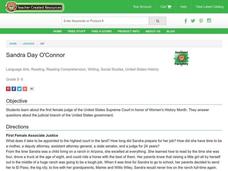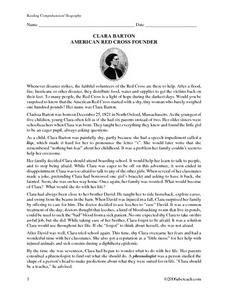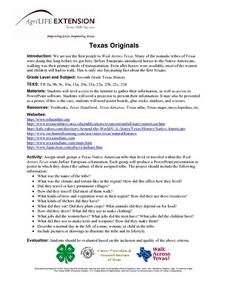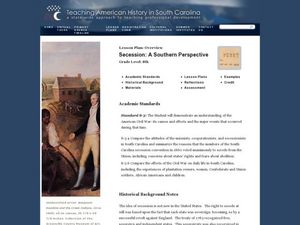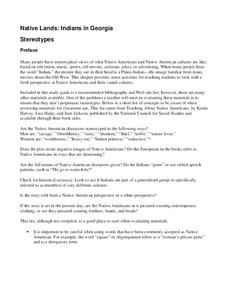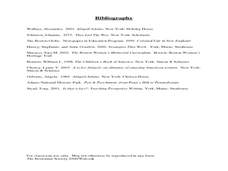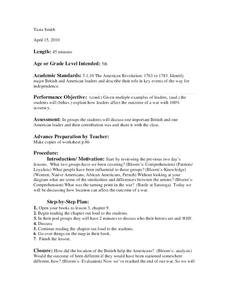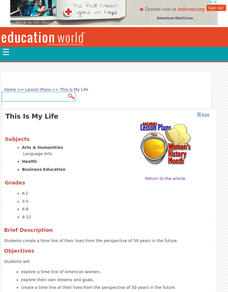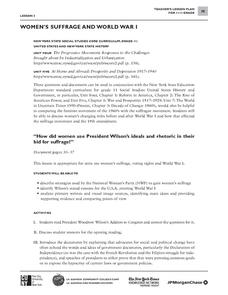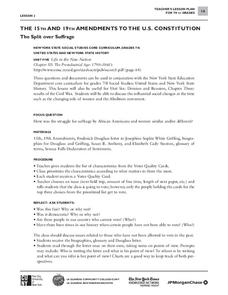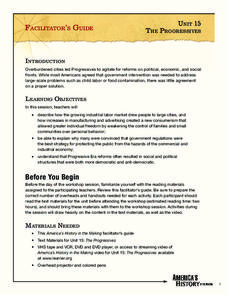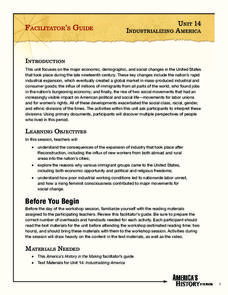Curated OER
Sandra Day O'Connor
No unit on important women in history would be complete without a lesson on Sandra Day O'Connor. After reading background information about the first female Supreme Court justice, middle schoolers engage in several activities addressing...
Curated OER
Introduction to Reform Movements of the 1800s
Eleventh graders consider the impact of reform movements of the 19th century. In this Progressive Reform lesson, 11th graders examine documents and images associated with women's suffrage, prohibition, and labor reform. Students respond...
Curated OER
Clara Barton Biography Reading Comprehension
In this reading comprehension worksheet, 4th graders will read a 3 page expository passage about Clara Barton, the founder of the American Red Cross. They will then answer 10 questions based on the passage.
Curated OER
Texas Originals
Seventh graders research the Native Americans of Texas. They create a PowerPoint presentation or poster showing the culture of the Native American tribe they were assigned.
Curated OER
Secession: A Southern Perspective
Eighth graders determine how secession impacted South Carolina as well as the United States. In this American Civil War lesson, 8th graders examine selected primary and secondary sources in order to study the state's sovereignty and the...
Curated OER
Native Lands: Indians in Georgia
Learners research what Native Americans looked like in order to dispel common stereotypes. In this Native American history lesson plan, students begin by drawing their mental picture of an Indian, then they research North American...
Curated OER
Abigail Adams: Integrating Social Studies and Language Arts
Third graders increase reading strategies while learning about Abigail Adams and her role in history. In this Abigail Adams instructional activity, 3rd graders read about the American Revolution and Abigail Adams using all the balanced...
Curated OER
Native Lands: Indians in Georgia
Students investigate the Native Americans of the Muscogee Creek and their use of the land. In this U.S. history lesson, students investigate the importance of the deer for the Muscogee Creek peoples' way of life and the many uses they...
Curated OER
The American Revolution
Fifth graders read about the Revolutionary War. In this history lesson, 5th graders review what they know about the the Revolutionary War in order to identify British and American leaders. Students read a chapter from their...
Curated OER
This Is My Life
Learners create a time line of their lives from the perspective of 50 years in the future.
National Woman's History Museum
Martha Hughes Cannon: Doctor, Wife, Mother, Senator
Each state is entitled to two statues in the National Statuary Hall Collection in Washington, D.C. After reading about Utah's debate over whether or not Martha Hughes Cannon should be represented by one of their statues, individuals...
Daughters of the American Revolution
Lesson 1: How Do Society’s Expectations Influence Education?
The history of women's education can be traced back to the delicate stitching of student samplers from the 19th century. Modern-day pupils examine and analyze four primary sources, three of which are images of embroidered samplers, which...
City University of New York
Woman's Suffrage and World War I
How did women use President Wilson's ideals and rhetoric in their bid for suffrage? To answer this essential question, class groups analyze primary written documents and visual images.
City University of New York
The 15th and 19th Amendments to the U.S. Constitution
Who gets to vote? Learn more about struggles for suffrage throughout United States history with a lesson based on primary source documents. Middle schoolers debate the importance of women's suffrage and African American...
NPR
Young And Brave Lesson Plan
Honor brave young women with a lesson that showcases 30 individuals who's achievements made a lasting impression on our country's history. Here, scholars randomly choose a person to examine from an interactive myseum exhibit then share...
Smithsonian Institution
World War I
How did World War I effect the United States' status as a world power? Pupils examine a website to learn many interesting facts about American involvement during World War I. They read passages and interact with artifacts in an online...
Facing History and Ourselves
The Audacity of a Vote: Susan B. Anthony’s Arrest
Susan B. Anthony's speech "Is It a Crime for Women to Vote?" takes center stage in a instructional activity that asks class members to consider how they might respond to what they consider an unjust law. Groups work through the speech...
Annenberg Foundation
Egalitarian America
What does a true American represent? Scholars investigate the equal rights era of the 1960s and 1970s in the 20th installment of a 22-part series on American history. Using photographic, magazine, written, and video evidence, groups...
Stanford University
Lesson Plan: The Children's Crusade and the Role of Youth in the African American Freedom Struggle
Young people played significant roles in the Civil Rights movement. Class members examine the contributions of Barbara Johns, Claudette Colvin, Mary Louise Smith, and the children of Birmingham,...
Annenberg Foundation
The Progressives
The Progressive Era brought about a word that often leads to turmoil—change! Learners research the late 1800s in American history to uncover societal issues gripping the nation back in the day. The 15th lesson of a 22-part series...
Smithsonian Institution
Eastern Indian Wars
Many know that Native Americans were forced off their lands and moved west, but how did these people react? The Red Sticks faction of the Creek nation opted to defend themselves and their lands in a series of wars called the Eastern...
Curated OER
Chapter 28: Red Flags and Velvet Revolutions: The End of the Cold War, 1960-1990
Set your historians up for testing success using this interactive flashcard tool. It is one of many learning strategies offered in this thorough online resource. Although designed for use with a text, the site is valuable independently....
Learning to Give
Heroes with Heart
This resource provides a lesson that will have learners explain how women and minority figures worked for the common good of their community.
Annenberg Foundation
Industrializing America
Imagine an eight year old spindle boy working barefoot in a factory in the late 1800s. Scholars research the industrial period in American history in the 14th lesson of a 22-part series that explores the country's background. Groups...
